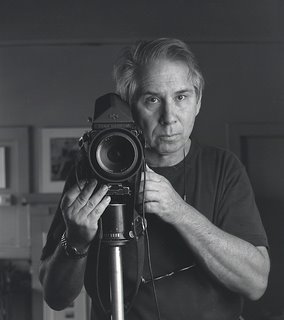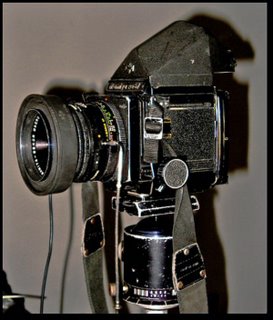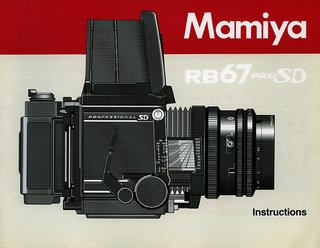Who shaves the barber?
From The Barbershop Paradox as proposed by Lewis Carroll in A Logical Paradox, July 1894.
When I remember, I photograph myself on my birthday. I took this shot August 31, 2006. I post it here as it has a more flattering view of my Mamiya RB67 Pro-SD. It looks in a lot better shape that the photo that follows.

Tim Bray in his ever popular ongoing wants to know more about my camera. He asks here. When I photographed him for my Georgia Straight profile in my studio he snapped my camera on its tripod with his digital. Here is his picture which shows a lot of the brass, not plastic, that lies beneath the black paint.

While I had taken photographs since I was 15 I did not choose photography as a profession until Rosemary, our two daughters and I decided to move to Vancouver in 1975. We drove to Vancouver in our VW Beetle and on the way I dropped them off in Disneyland and I went to a an LA photo store and bought all the equipment I thought I needed that I could not possibly have been able to afford in Mexico City. Mexico had high import tarifs.
But in Vancouver, with so many working photographers, I decided I needed some sort of competitive edge or calling card. I knew I did not want to see the world upside down as seen by a 4 x 5 inch view camera. I could not afford the medium format (uses 120 or twice as long roll film) Hasselblad. By 1975 so many could afford Nikons and parade in Stanley Park with one of them hanging around he neck that the Hasselblad was the status and macho symbol of the time. I opted for the less expensive but larger format (6x7 cm as oposed to Hasselblad's 6x6). Within a month of buying my first Mamiya RB-67 Pro-S with a 65mm (equivalent to a 35mm in the 35mm film format) I had Rick Staehling of Vancouver Magazine call me for a job in which he specifically requested, "Alex do you think you could use that monster-sized new-fangled camera you showed me?" A couple of years later that RB fell into Dana Zalko's hot tub (it was a magazine assignment!) complete with the tripod. The lens had been too heavy for the precarious balance so the whole unit collapsed into the water. Two days later the boys (Bert and Attila) at Precision Camera Repair (on Burrard but long gone) had it in pristine working conditions all over again.
Because I have always believed in the NASA Plan B and C of coping with mechanical glitches I bought a second used one. Except for my first camera and the third one seen here, a Mamiya Pro-SD (it has some slight variations to my other two), every piece of Mamiya equipment I own I have bought used. While the finish, particularly inside the camera and lenses cannot possibly be equal to the standards of a Hasselblad, the camera is sturdy, reliable but heavy.
The lens seen here is the 140mm (equivalent to a 75mm in the 35mm film format). This lens, like all Mamiya RB lenses, has a shutter inside the lens. This shutter will sync with flash at any speed but it has the drawback of a maximum of 1/400 second shutter speed which I have realistically tested at around 1/300, on good days. The ability to make great elargements from 6x7 cm negatives and slides is greatly aided by that 140mm (and the 65mm and 50mm which I also have). Why?
Lenses are designed to be sharp at infinity and the image beging to deteriorate as you focus closely. Close focusing lenses(only very few of the very good ones) and true macro lenses (more on this later) are built to focus closely and the image deteriorates as you focus towards infinity. A true macro lens is defined as a lens (as an example) that will record a 1 inch stamp (as an example) as one inch on the film (or in a digital camera) or sensor plane. The RB has bellows between the lens and the camera body. With these bellows I am able to focus my RB on my thumb nail and record it actual size. In photographic lingo this is called 1 to 1 reproduction. That's how you define a true macro lens.

The Mamiya 140mm, 65mm and 50mm lenses are floating element macro lenses. These are lenses that combine the best of normal lenses (that are designed to focus at infinity) with macro lenses that are designed for sharp closeups. They do both by having a floating element. Once I adjust my focus (let's say on a head and shoulders portrait), I adjust the floating element ring. When I do this a group of glass elements within the lens adjust for optimum sharpness at that distance.
My 140mm lens is sharp.
Because of its weight I can shoot more comfortably with the camera on my 34-year-old Italian Manfrotto tripod. A tripod is only as good as its head. The head is an Arca Swiss Monoball. I can move my camera in any direction (as in any) by loosening only one knob. The movement is as smooth as silk.
Another spectacular feature of the Mamiya RB is that the back (where the film is) and which can be interchanged at any time with other backs with other types of film (I have 5 backs) rotates so that the 6x7 format can be in vertical or horizontal position. You can do this without having to rotate the whole camera.
If I were to equal the performance of this camera digitally (in detail and enlargability) I would have to spend in the neighbourhood of $50.000. This would buy me a digital back that would replace the film backs. I would need further equipment like a laptop to which I would have to tether the camera. All that and additional software would be prohibitive for me now. My obsolete Mamiya will have to soldier on.
But the best feature of my Mamiya, its reduced exposures "capability" (10 shots per roll of 120 film) has taught me through the years to really study and concentrate on what I am doing before I press the shutter. I shoot very little on my assignments. The camera has few knobs. I can concentrate on my subjects and my Mamiya fades into the background of my mind and performs with a dependability which for me is a legendary one.
Part of the dependability of my RB which I also call my Sword Excalibur is due to Horst Wenzel who keeps all my cameras in top shape.






